Comparison between Conventional and Non-Conventional Computer Methods to Define Antiknock Properties of Fuel Mixtures
Abstract
:1. Introduction
2. Methodology
2.1. Zero-Dimensional Engine Thermodynamics Model
2.2. Kinetics Scheme and Chemical Reactor
- Reduced_279, derived from the previous one by adopting reduction method DRGEP + SA [21] on 20 operative points, achieving 279 species and 8367 reactions.
| Component (Formula) | Class | RON/MON (-) | LHV/HHV (MJ/kg) | SAFR 1 (-) |
|---|---|---|---|---|
| i-Octane (iC8H18) | i-Alkanes | 100/100 | 44.61/48.07 | 15.028 |
| n-Pentane (nC5H12) | n-Paraffins | 62/62 | 45.33/48.99 | 15.227 |
| n-Heptane (nC7H16) | n-Paraffins | 0/0 | 44.53/47.66 | 14.686 |
| Ethanol (C2H5OH) | Alcohols | 109/90 | 27.72/30.59 | 8.934 |
| 1-Hexene (1-C6H12) | Olefins | 76/63.4 | 44.79/47.92 | 14.686 |
| Cyclohexane (C6H12) | Naphthenes | 82.5/77.2 | 43.81/46.95 | 14.686 |
| Methylcyclohexane (C7H14) | Naphthenes | 74.1/71 | 43.72/46.86 | 14.686 |
| Toluene (C6H5CH3) | Aromatics | 118/103.5 | 40.93/42.84 | 13.414 |
| 124-Trimethylbenzene (C6H5C6H5) | Aromatics | 107.4/97.9 | 41.31/43.38 | 14.686 |
| 1-Pentene (1-C5H10) | Olefins | 90/77.1 | 44.81/47.95 | 15.227 |
| n-Decane (nC10H22) | n-Paraffins | −15/0 | 45.33/48.99 | 15.0 |
3. Results
3.1. Weighted Sum
3.2. Reactor: P,T from Reference vs. P,T from Engine Thermodynamics Model
3.3. Comparison
4. Conclusions
Supplementary Materials
Author Contributions
Funding
Institutional Review Board Statement
Informed Consent Statement
Data Availability Statement
Conflicts of Interest
References
- Boretti, A. Water injection in directly injected turbocharged spark ignition engines. Appl. Therm. Eng. 2013, 52, 62–68. [Google Scholar] [CrossRef]
- Kim, J.; Park, H.; Bae, C.; Choi, M.; Kwak, Y. Effects of water direct injection on the torque enhancement and fuel consumption reduction of a gasoline engine under high-load conditions. Int. J. Engine Res. 2016, 17, 795–808. [Google Scholar] [CrossRef]
- Kaminaga, T.; Yamaguchi, K.; Ratnak, S.; Kusaka, J.; Youso, T.; Fujikawa, T.; Yamakawa, M. A Study on Combustion Characteristics of a High Compression Ratio SI Engine with High Pressure Gasoline Injection. In Proceedings of the 14th International Conference on Engines & Vehicles, Capri, Napoli, Italy, 15–19 September 2019. [Google Scholar]
- ASTM Standard D2700; Standard Test Method for Motor Octane Number of Spark Ignition Engine Fuel. Annual Book of ASTM Standards; ASTM: West Conshohocken, PA, USA, 2004.
- ASTM Standard D2699; Standard Test Method for Research Octane Number of Spark-Ignition Engine Fuel. Annual Book of ASTM Standards; ASTM: West Conshohocken, PA, USA, 2004.
- Fieweger, K.; Blumenthal, R.; Adomeit, G. Self-Ignition of S.I. Engine Model Fuels: A Shock Tube Investigation at High Pressure. Combust. Flame 1997, 109, 599–619. [Google Scholar] [CrossRef]
- Kim, N.; Vuilleumier, D.; Sjöberg, M.; Yokoo, N.; Tomoda, T.; Nakata, K. Using Chemical Kinetics to Understand Effects of Fuel Type and Compression Ratio on Knock-Mitigation Effectiveness of Various EGR Constituents. SAE Int. J. Adv. Curr. Prac. Mobil. 2019, 1, 1560–1580. [Google Scholar]
- Cai, L.; Pitsch, H. Optimized chemical mechanism for combustion of gasoline surrogate fuels. Combust. Flame 2015, 162, 1623–1637. [Google Scholar] [CrossRef] [Green Version]
- Westbrook, C.K.; Sjöberg, M.; Cernansky, N.P. New Chemical Kinetic Method of Determining RON and MON Values for Single Component and Multicomponent Mixtures of Engine Fuels. Combust. Flame 2018, 195, 50–62. [Google Scholar] [CrossRef]
- Woschni, G.A. A Universally Applicable Equation for the Instantaneous Heat Transfer Coefficient in the Internal Combustion Engine. SAE Trans. 1967, 76, 3065–3083. [Google Scholar]
- Ghojel, J.I. Review of the development and applications of the Wiebe function: A tribute to the contribution of Ivan Wiebe to engine research. Int. J. Engine Res. 2010, 11, 297–312. [Google Scholar] [CrossRef]
- Verhelst, S.; Sheppard, C. Multi-zone thermodynamic modelling of spark-ignition engine combustion—An overview. Energy Convers. Manag. 2009, 50, 1326–1335. [Google Scholar] [CrossRef] [Green Version]
- Cantera. Available online: https://cantera.org/ (accessed on 4 March 2022).
- Pal, P.; Kolodziej, C.; Broatch, A.; Gomez-Soriano, J. Development of a Virtual CFR Engine Model for Knocking Combustion Analysis. SAE Int. J. Engines 2018, 11, 1069–1082. [Google Scholar] [CrossRef]
- Li, R.; Herreros, J.M.; Tsolakis, A.; Yang, W. Integrated machine learning-quantitative structure property relationship (ML-QSPR) and chemical kinetics for high throughput fuel screening toward internal combustion engine. Fuel 2021, 307, 121908. [Google Scholar] [CrossRef]
- Correa Gonzalez, S.; Kroyan, Y.; Sarjovaara, T.; Kiiski, U.; Karvo, A.; Toldy, A.I.; Larmi, M.; Santasalo-Aarnio, A. Prediction of Gasoline Blend Ignition Characteristics Using Machine Learning Models. Energy Fuels 2021, 35, 9332–9340. [Google Scholar] [CrossRef]
- Yuan, H. Octane Blending and Oxidation Chemistry of Ethanol-Hydrocarbon Mixtures. Ph.D. Thesis, University of Melbourne, Melbourne, VIC, Australia, 9 March 2018. [Google Scholar]
- Ranzi, E.; Frassoldati, A.; Stagni, A.; Pelucchi, M.; Cuoci, A.; Faravelli, T. Reduced kinetic schemes of complex reaction systems: Fossil and biomass-derived transportation fuels. Int. J. Chem. Kinet. 2014, 46, 512–542. [Google Scholar] [CrossRef]
- Ranzi, E.; Frassoldati, A.; Stagni, A.; Pelucchi, M.; Cuoci, A.; Faravelli, T. New reaction classes in the kinetic modeling of low temperature oxidation of n-alkanes. Combust. Flame 2015, 162, 1679–1691. [Google Scholar] [CrossRef]
- Bagheri, G.; Ranzi, E.; Pelucchi, M.; Parente, A.; Frassoldati, A.; Faravelli, T. Comprehensive kinetic study of combustion technologies for low environmental impact: MILD and OXY-fuel combustion of methane. Combust. Flame 2020, 212, 142–155. [Google Scholar] [CrossRef]
- Niemeyer, K.E.; Sung, C. Reduced Chemistry for a Gasoline Surrogate Valid at Engine-Relevant Conditions. Energy Fuels 2015, 29, 1172–1185. [Google Scholar] [CrossRef] [Green Version]
- Vom Lehn, F.; Cai, L.; Tripathi, R.; Broda, R.; Pitsch, H. A property database of fuel compounds with emphasis on spark-ignition engine applications. Appl. Energy Combust. Sci. 2021, 5, 100018. [Google Scholar] [CrossRef]
- Knop, V.; Loos, M.; Pera, C.; Jeuland, N. A linear-by-mole blending rule for octane numbers of n-heptane/iso-octane/toluene mixtures. Fuel 2014, 115, 666–673. [Google Scholar] [CrossRef]
- Sjöberg, M.; He, X. Combined effects of intake flow and spark-plug location on flame development, combustion stability and end-gas autoignition for lean spark-ignition engine operation using E30 fuel. Int. J. Engine Res. 2018, 19, 86–95. [Google Scholar] [CrossRef]
- Mariani, V.; Pulga, L.; Bianchi, G.M.; Cazzoli, G. A Bayesian neural network methodology to predict the liquid phase diffusion coefficient. Int. J. Heat Mass Transf. 2020, 161, 120309. [Google Scholar] [CrossRef]
- Mariani, V.; Pulga, L.; Bianchi, G.M.; Cazzoli, G.; Falfari, S. Neural Network-Based Prediction of Liquid Phase Diffusion Coefficient to Model Fuel-Oil Dilution on Engine Cylinder Walls. SAE Int. J. Engines 2020, 13, 649–664. [Google Scholar] [CrossRef]
- Marks, B.; Mathieu, O.; Archuleta, R.; Petersen, E.; Metcalfe, W.; Curran, H.; Bourque, G. Ignition Delay Time Measurements and Modeling of n-Pentane and iso-Pentane at Elevated Pressures. In Proceedings of the 51st AIAA Aerospace Sciences Meeting including the New Horizons Forum and Aerospace Exposition, Grapevine, TX, USA, 7–10 January 2013; p. 160. [Google Scholar]
- Hartmann, M.; Gushterova, I.; Fikri, M.; Schulz, C.; Schießl, R.; Maas, U. Auto-ignition of toluene-doped n-heptane and iso-octane/air mixtures: High-pressure shock-tube experiments and kinetics modeling. Combust. Flame 2011, 158, 172–178. [Google Scholar] [CrossRef]
- Roy, S.; Hadi, F.; Askari, O. Detailed Chemical Mechanism Generation for Combustion of Ethanol-Air Mixture. In ASME International Mechanical Engineering Congress and Exposition; American Society of Mechanical Engineers: New York, NY, USA, 2019; Volume 59438, p. V006T06A005. [Google Scholar]
- Roy, S.; Askari, O. A New Detailed Ethanol Kinetic Mechanism at Engine-Relevant Conditions. Energy Fuels 2020, 34, 3691–3708. [Google Scholar] [CrossRef]
- Dong, S.; Aul, C.; Gregoire, C.; Cooper, S.P.; Mathieu, O.; Petersen, E.L.; Rodriguez, J.; Maussd, F.; Wagnone, S.W.; Kukkadapue, G.; et al. A comprehensive experimental and kinetic modeling study of 1-hexene. Combust. Flame 2021, 232, 111516. [Google Scholar] [CrossRef]
- Vranckx, S.; Lee, C.; Chakravarty, H.K.; Fernandes, R.X. A rapid compression machine study of the low temperature combustion of cyclohexane at elevated pressures. Proc. Combust. Inst. 2013, 34, 377–384. [Google Scholar] [CrossRef]
- Andrae, J.C.G. Kinetic Modeling of the Influence of Cyclohexane on the Homogeneous Ignition of a Gasoline Surrogate Fuel. Energy Fuels 2018, 32, 3975–3984. [Google Scholar] [CrossRef]
- Vasu, S.S.; Davidson, D.F.; Hong, Z.; Hanson, R.K. Shock tube study of methylcyclohexane ignition over a wide range of pressure and temperature. Energy Fuels 2009, 23, 175–185. [Google Scholar] [CrossRef]
- Andrae, J.C.; Björnbom, P.; Cracknell, R.F.; Kalghatgi, G.T. Autoignition of toluene reference fuels at high pressures modeled with detailed chemical kinetics. Combust. Flame 2007, 149, 2–24. [Google Scholar] [CrossRef]
- Liu, Y.X.; Wang, B.Y.; Weng, J.J.; Yu, D.; Richter, S.; Kick, T.; Naumannc, C.; Braun-Unkhoffc, M.; Tian, Z.Y. A wide-range experimental and modeling study of oxidation and combustion of n-propylbenzene. Combust. Flame 2018, 191, 53–65. [Google Scholar] [CrossRef] [Green Version]
- Skjoth-Rasmussen, M.; Braun-Unkhoff, M.; Naumann, C.; Frank, P. Experimental and Numerical Study of n-Decane Chemistry. In Proceedings of the 1st European Combustion Meeting, Orléans, France, 25–28 October 2003. [Google Scholar]
- Cancino, L.R.; Fikri, M.; Oliveira, A.A.M.; Schulz, C. Autoignition of gasoline surrogate mixtures at intermediate temperatures and high pressures: Experimental and numerical approaches. Proc. Combust. Inst. 2009, 32, 501–508. [Google Scholar] [CrossRef]
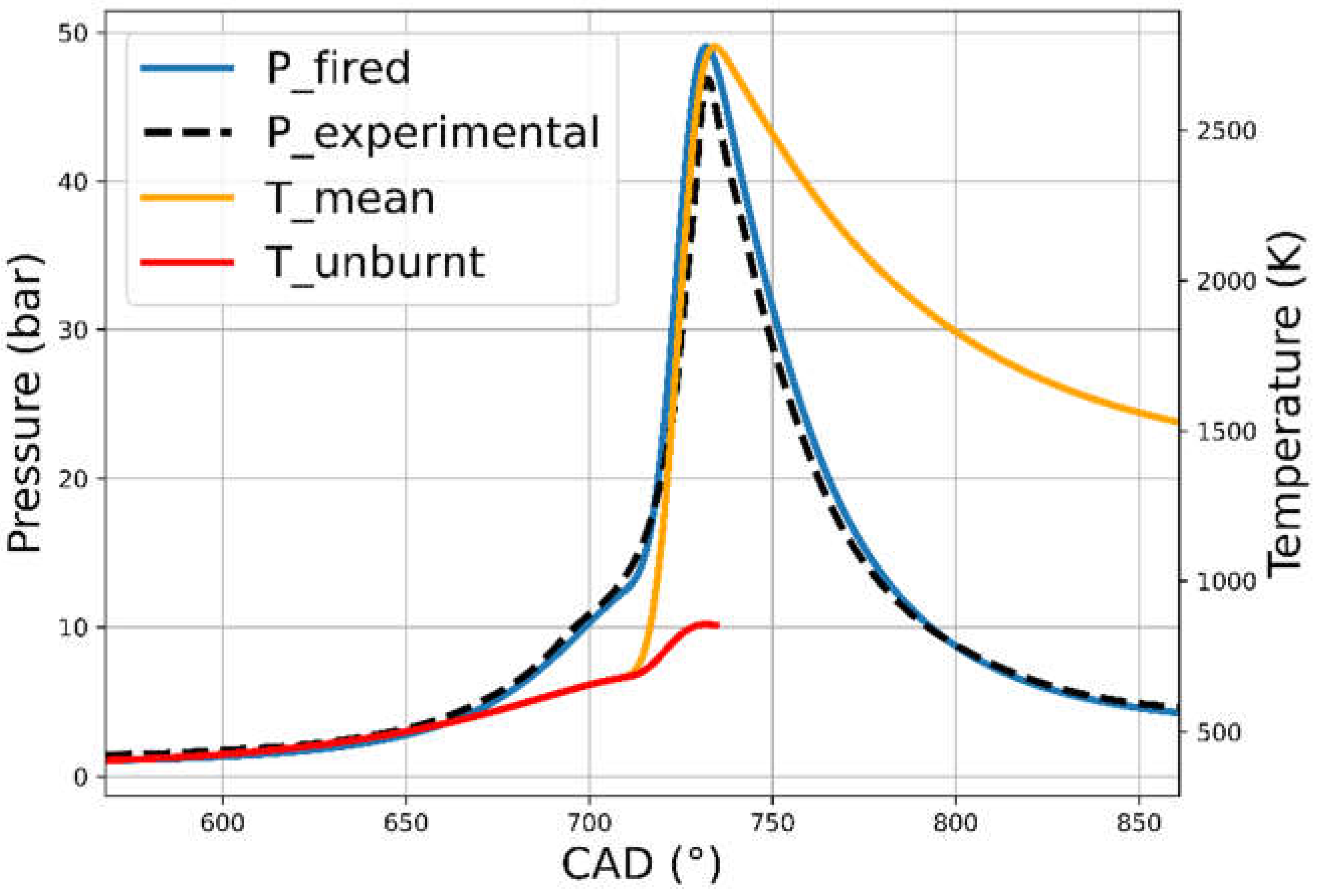

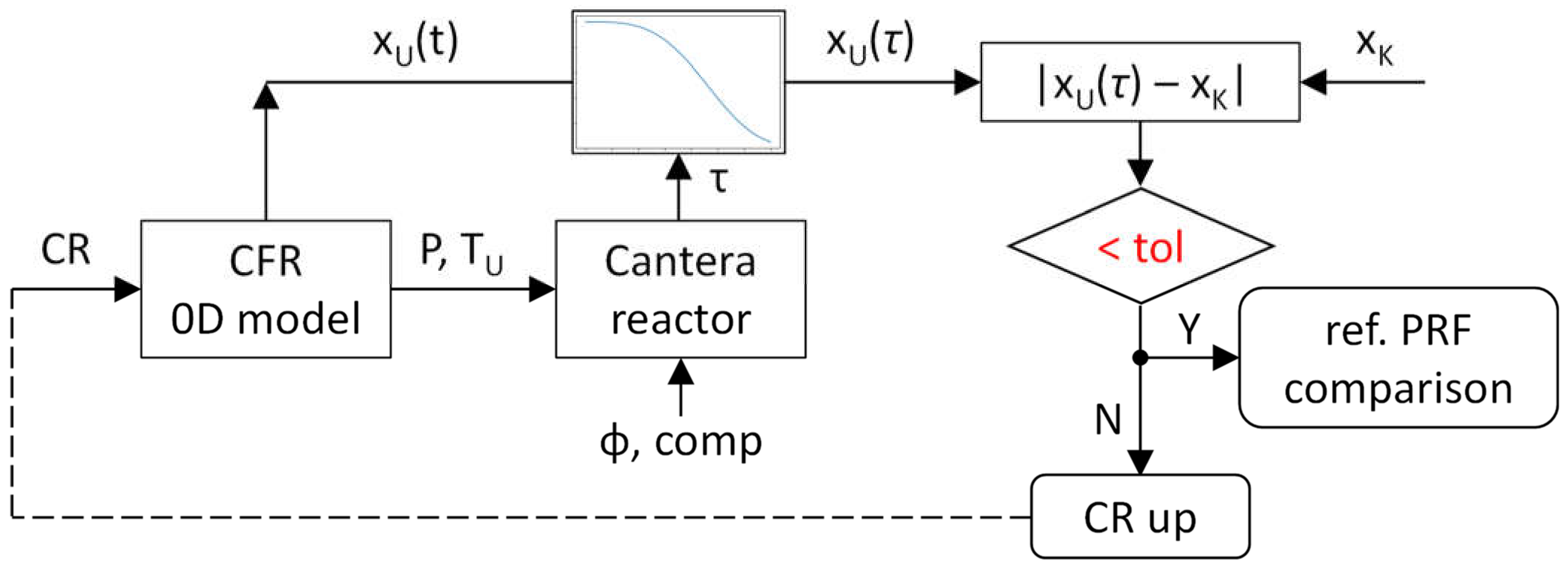
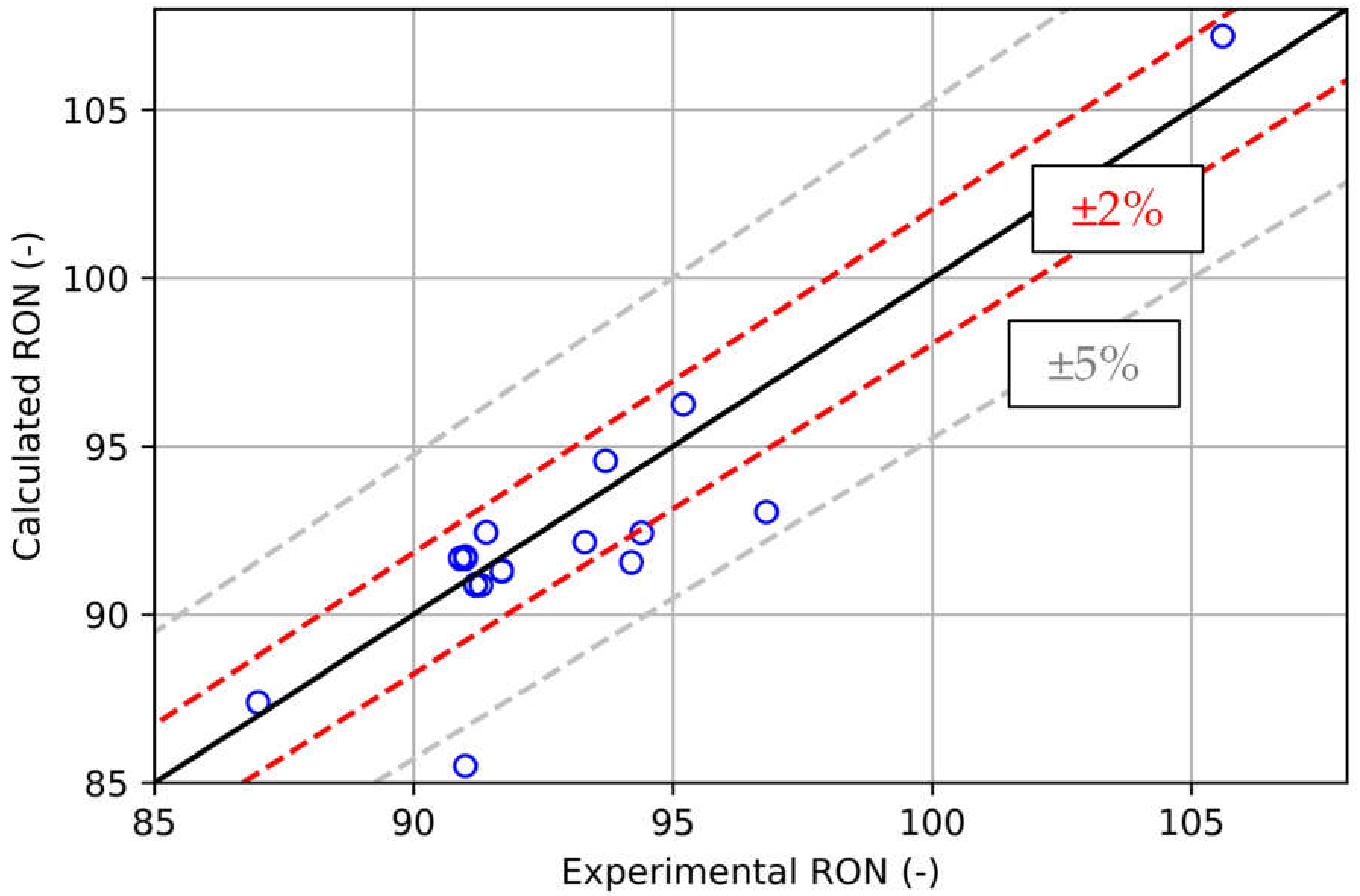
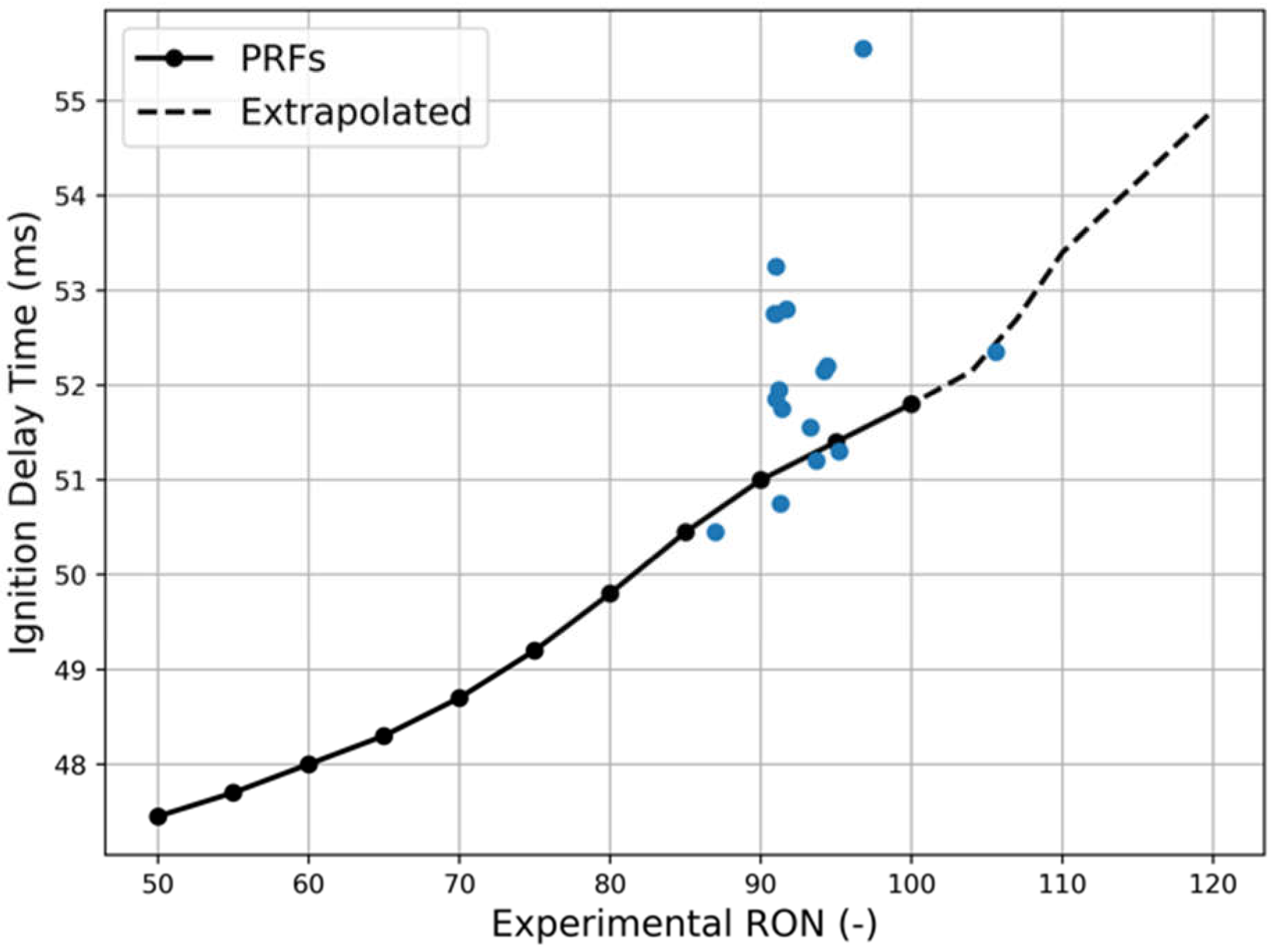
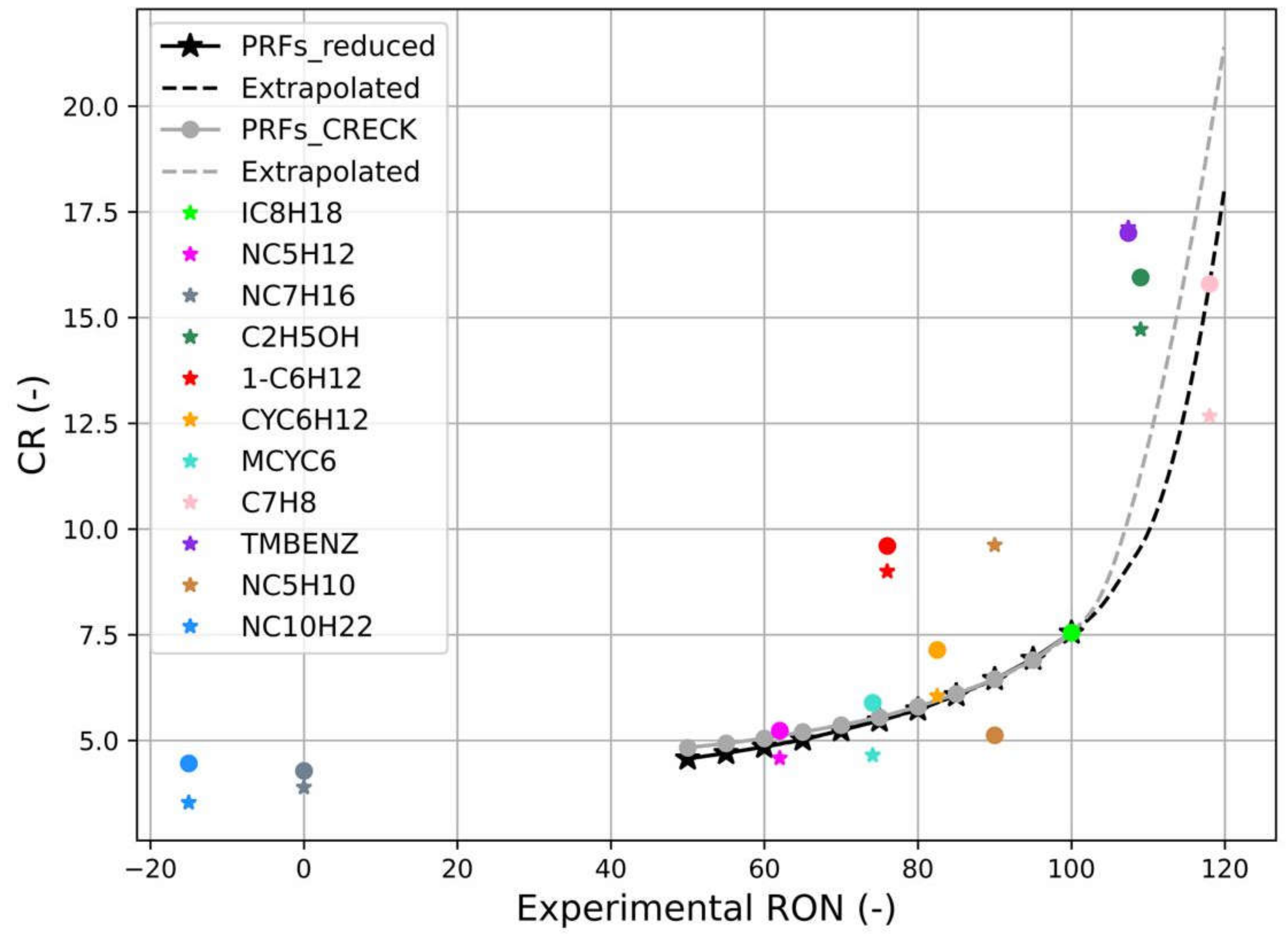
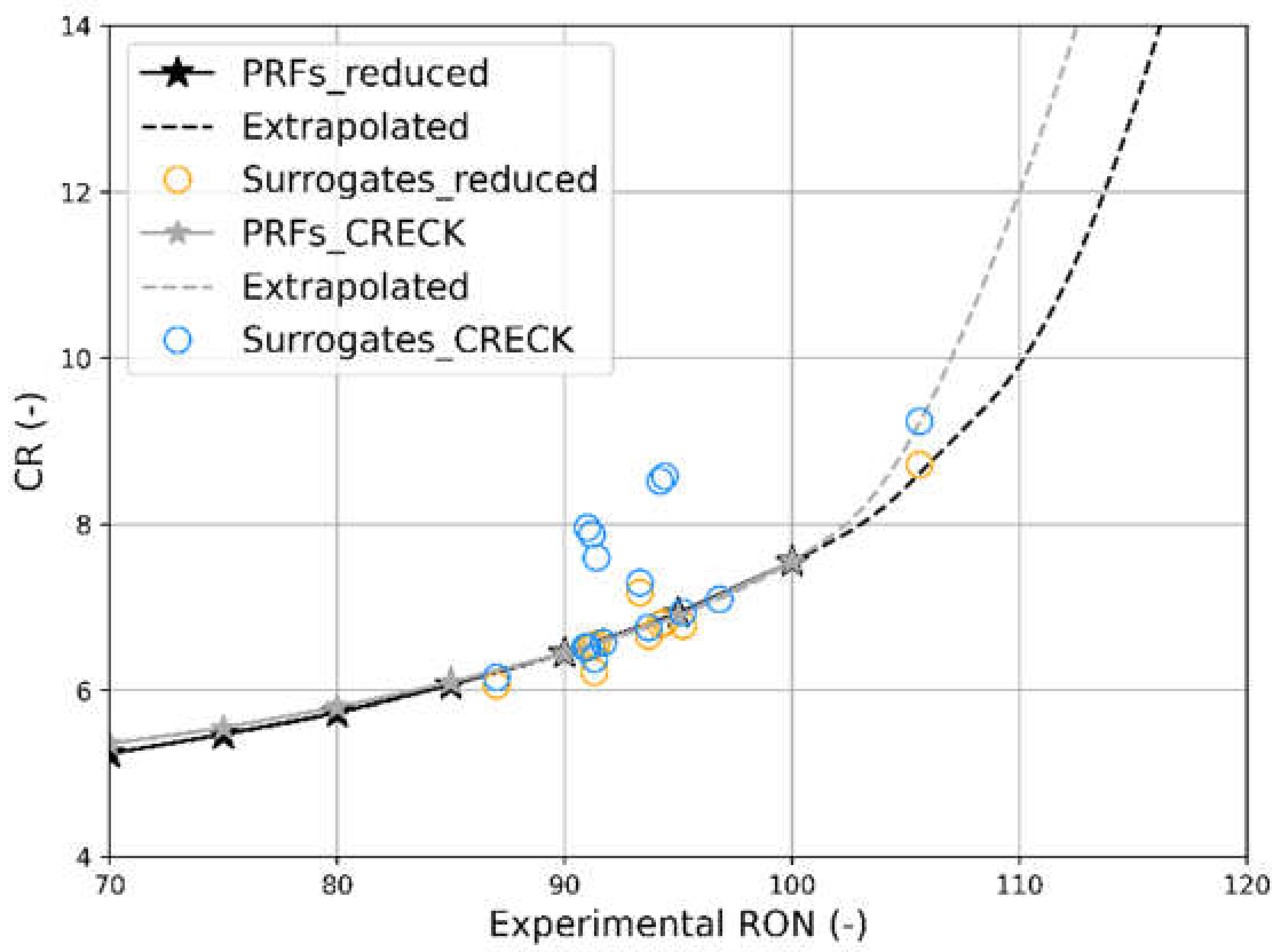
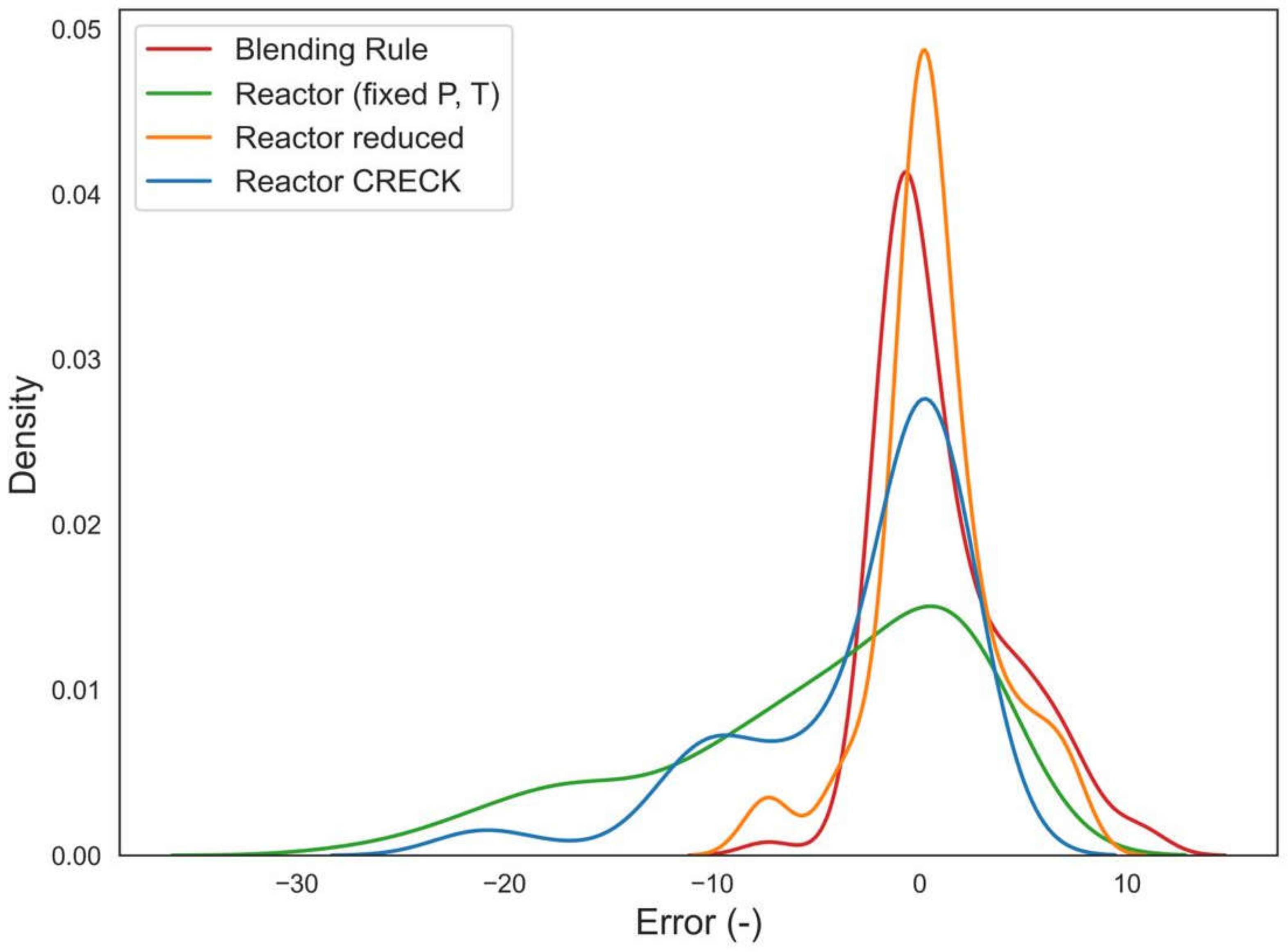

| Specification | RON Test | MON Test |
|---|---|---|
| Engine speed (r/min) | 600 | 900 |
| Air inlet temp. (°C) | 52 | 38 |
| Mixture inlet temp. (°C) | Not controlled | 149 |
| Spark timing (CAD bTDC) 1 | 13 | 19–26 |
| Specification | Value |
|---|---|
| Displacement (cc) | 611.2 |
| Bore (mm) | 82.55 |
| Stroke (mm) | 114.3 |
| Conrod length (mm) | 254 |
| Compression ratio (-) | Variable (4:1 to 18:1) |
| Method | Mean Abs. Err. (%) | RSME (%) | R2 (-) | Max. Err. (%) |
|---|---|---|---|---|
| Blending rule | 2.36 | 3.37 | 0.884 | 10.90 |
| Reduced scheme–Reactor (P, T ref.) | 6.44 | 9.09 | 0.157 | 26.90 |
| Reduced scheme–Reactor (P, T engine model) | 1.95 | 3.01 | 0.908 | 7.40 |
| Complete scheme–Reactor (P, T engine model) | 3.68 | 6.27 | 0.599 | 21.64 |
| Calculation Method | Simulation Time (ms) |
|---|---|
| Blending rule | - |
| Reduced scheme–Reactor (P, T ref.) | 49,146.802 |
| Reduced scheme–Reactor (P, T engine model) | 119,722.026 |
| Complete scheme–Reactor (P, T engine model) | 275,144.903 |
Publisher’s Note: MDPI stays neutral with regard to jurisdictional claims in published maps and institutional affiliations. |
© 2022 by the authors. Licensee MDPI, Basel, Switzerland. This article is an open access article distributed under the terms and conditions of the Creative Commons Attribution (CC BY) license (https://creativecommons.org/licenses/by/4.0/).
Share and Cite
Pulga, L.; Lacrimini, D.; Forte, C.; Mariani, V.; Falfari, S.; Bianchi, G.M. Comparison between Conventional and Non-Conventional Computer Methods to Define Antiknock Properties of Fuel Mixtures. Fuels 2022, 3, 217-231. https://doi.org/10.3390/fuels3020014
Pulga L, Lacrimini D, Forte C, Mariani V, Falfari S, Bianchi GM. Comparison between Conventional and Non-Conventional Computer Methods to Define Antiknock Properties of Fuel Mixtures. Fuels. 2022; 3(2):217-231. https://doi.org/10.3390/fuels3020014
Chicago/Turabian StylePulga, Leonardo, Diego Lacrimini, Claudio Forte, Valerio Mariani, Stefania Falfari, and Gian Marco Bianchi. 2022. "Comparison between Conventional and Non-Conventional Computer Methods to Define Antiknock Properties of Fuel Mixtures" Fuels 3, no. 2: 217-231. https://doi.org/10.3390/fuels3020014
APA StylePulga, L., Lacrimini, D., Forte, C., Mariani, V., Falfari, S., & Bianchi, G. M. (2022). Comparison between Conventional and Non-Conventional Computer Methods to Define Antiknock Properties of Fuel Mixtures. Fuels, 3(2), 217-231. https://doi.org/10.3390/fuels3020014







